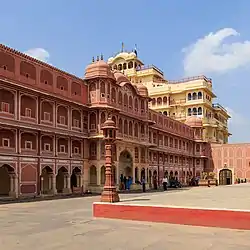List of Rajput dynasties and states
During the medieval and later feudal/colonial periods, many parts of the Indian subcontinent were ruled as sovereign or princely states by various dynasties of Rajputs.
| Princely state |
|---|
| Individual residencies |
|
| Agencies |
|
| Lists |
Early medieval dynasties
The term "Rajput" has been used as an anachronistic designation for several Hindu dynasties that confronted the Ghaznavid and Ghurid invaders during the 11th and 12th centuries. Although the Rajput identity did not exist at this time, these lineages were classified as aristocratic Rajput clans in the later times.[1][2]
- Gurjara-Pratiharas of Kannauj
- Chahamanas (of Shakambhari, Nadol, Ranastambhapura and Jalor)
- Tomaras of Delhi
- Chaulukyas (Solankis) and Vaghelas of Gujarat
- Paramaras of Malwa and Chandravati
- Gahadavalas of Varanasi and Kannauj
- Chandelas of Jejakabhukti (modern Bundelkhand)
- Guhilas of Medapata (modern Mewar)
- Kachchhapaghatas of Gopadri (modern Gwalior)
Rajput kingdoms and chieftaincies

During their centuries-long rule of northern India, the Rajputs constructed several palaces. Shown here is the Chandramahal in City Palace, Jaipur, Rajasthan, which was built by the Kachwaha Rajputs.
Following is the list of those ruling Rajput dynasties of the Indian Subcontinent:
- Amethia of Birsinghpur[3]
- Chauhan State of Kotah and Bundi princely states[7]
- Gandhavariyas of North Bihar including Sonbarsa Raj.[9]
- Gaur of Gaurati, Gorwar, Panch Mahal Maroth, Sheopur, Sopra, Ranka, Gadi Arjunpura Riayasat, Rajgarh, Bengal and Birsinghpur.
- Gohils of Gohilvaad.
- Jethwa of Porbandar State[11]
- Kansaras of Gujarat: Ruled over Mahishamati Kingdom.[13]
- Katoch dynasty of Kangra: Ruled much of Himachal Pradesh and parts of Punjab.[14]
- Parhar, Parihara and Pratihara dynasties of Kannauj.[17] Conquered Kannauj in 816 AD, which remained its capital for about a century, declined in the 10th century. Alipura State, Kumharsain, And Rajputana
- Ujjainiyas of Bhojpur, Bihar including Dumraon Raj and Jagdishpur estate.[22]
See also
- List of Hindu Empires and Dynasties
- List of Indian monarchs
- Rajputana
References
- Talbot 2015, p. 33-35.
- Jackson 2003, p. 9.
- Lethbridge, Sir Roper (1893). The Golden Book of India: A Genealogical and Biographical Dictionary of the Ruling Princes, Chiefs, Nobles, and Other, Personages, Titled or Decorated, of the Indian Empire. Forgotten Books. ISBN 9788187879541.
- John F. Richards (1995). The Mughal Empire. Cambridge University Press. p. 275. ISBN 978-0-521-56603-2.
- Trudy Ring; Noelle Watson; Paul Schellinger (12 November 2012). Asia and Oceania: International Dictionary of Historic Places. Routledge. p. 392. ISBN 978-1-136-63979-1.
- Amir Ahmad (2005–2006). "The Bundela Revolts During The Mughal Period: A Dynastic Affair". Proceedings of the Indian History Congress. 66: 438–445. JSTOR 44145860.
- Norbert Peabody (2003). Hindu Kingship and Polity in Precolonial India. Cambridge University Press. p. 18. ISBN 978-0-521-46548-9.
- B. S. Ahloowalia (2009). Invasion of the Genes Genetic Heritage of India. Strategic Book Publishing. p. 114. ISBN 978-1-60860-691-7.
- P. Pathak (1983). "Origin of the Gandhavaria Rajputs of Mithila". The Journal of the Bihar Puravid Parisad. Vii And Viii: 406–420.
- Mcleod, John (6–9 July 2004). The Rise and Fall of the Kutch Bhayati (PDF). Eighteenth European Conference on Modern South Asian Studies, University of Lund. p. 5. Archived from the original (PDF) on 7 March 2012. Retrieved 13 September 2012.
- P.S. Nagar (1 September 2005). Floristic Biodiversity of Barda Hills and its Surroundings. Scientific Publishers. p. 13. ISBN 978-93-87741-15-7.
- McLeod, John (1999). Sovereignty, Power, Control: Politics in the States of Western India, 1916-1947. BRILL. ISBN 9789004113435.
- Jesse Russell, Ronald Cohn, ed. (2012). Sahastraarjun. p. 98. ISBN 9785511868882.
- dynasty of Himchal
- Tahir Hussain Ansari (20 June 2019). Mughal Administration and the Zamindars of Bihar. Taylor & Francis. pp. 355–. ISBN 978-1-00-065152-2.
- Jeffrey Witsoe (5 November 2013). Democracy against Development: Lower-Caste Politics and Political Modernity in Postcolonial India. University of Chicago Press. pp. 142–. ISBN 978-0-226-06350-8.
- The History of India by Kenneth Pletcher
- B Virottam (1984). "Aspects of Economic Transformation of the Medieval Chotanagpur Tribes". Proceedings of the Indian History Congress. 45: 384–390. JSTOR 44140219.
- Sunita Zaidi (2003). "Notes on Demography of the Ruling Rajput Families of Rajasthan (16th - 18th century)". Proceedings of the Indian History Congress. 64: 591–595. JSTOR 44145493.
- Studies In Indian History: Rajasthan
- Joanna Williams, Kaz Tsuruta, ed. (2007). Kingdom of the sun. Asian Art Museum - Chong-Moon Lee Center for Asian Art and Culture. pp. 15–16. ISBN 9780939117390.
- Kolff, Dirk H. A. (8 August 2002). Naukar, Rajput, and Sepoy: The Ethnohistory of the Military Labour Market in Hindustan 1450-1850. p. 181. ISBN 9780521523059. Retrieved 14 January 2017.
Notes
- Talbot, Cynthia (2015). The Last Hindu Emperor: Prithviraj Cauhan and the Indian Past, 1200–2000. Cambridge University Press. ISBN 9781107118560.
- Jackson, Peter (2003). The Delhi Sultanate: A Political and Military History. Cambridge University Press. ISBN 978-0-521-54329-3.
This article is issued from Wikipedia. The text is licensed under Creative Commons - Attribution - Sharealike. Additional terms may apply for the media files.